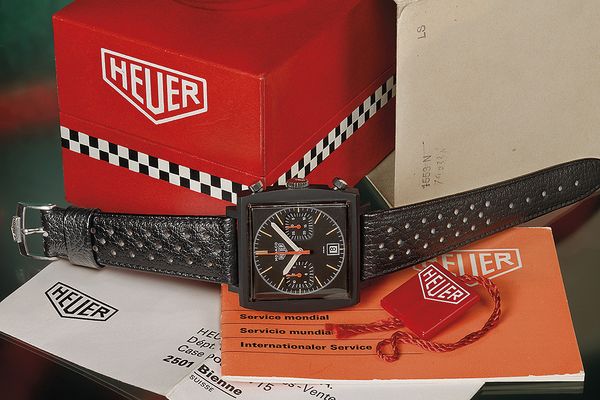Heuer Monaco "Dark Lord" Ref. 740303N, circa 1975
If the Autavia is the latest and perhaps greatest ambassador of the vintage Heuer world, the Monaco "Dark Lord" remains the undisputable fan favorite. The all-black Monaco is one of the rarest Heuers and at one point held the public record for the most expensive Heuer ever sold.
Later this month, the "Dark Lord" will be given an opportunity to reclaim that title, which currently belongs to a first execution Autavia ref. 2446. The chances are slim to none (another Autavia offered in the same sale could do even better), but the very best "Dark Lord" example is being put forward, and because this is auction, one can never truly predict the final result.
But first, a little perspective.
[It is] hugely recognizable due to its large square case and one very important cameo in Le Mans, on the wrist of Steve McQueen.
The Monaco ref. 1133 was Heuer's first self-winding chronograph, and one of the first self-winding chronographs, period. It's a watch that’s historically important because of its movement, but it is also hugely recognizable due to its large square case and one very important cameo in Le Mans, on the wrist of Steve McQueen.
Initially, though, the Monaco was not a great commercial success. The Autavia and the Carrera were much more popular, which may have indirectly led to the creation of the "Dark Lord." The lack of interest in the Monaco gave Heuer license to experiment, and that's exactly what it did, in 1974, when it put a few cases through a newly developed blackening treatment.
The resutling PVD Monacos were fitted with a small batch of unused Valjoux 7740 movements, which run faster than other Monaco movements and have the winding crown placed on the right side, between the chronograph pushers.
The dial design though was similar to the automatic steel reference 1133, with the same two registers for hour and minutes and a date window at 6 o'clock, but the new reference looked almost nothing like the original. The luminous bars, orange accents, raised register central numerals and all-black case and dial combo transformed this funky icon of the seventies into a strikingly modern timepiece.
To this day, nobody knows exactly how many PVD Monacos were made, but Jack Heuer recently said the company made between 100 and 200 examples. Either way, the ‘Dark Lord’ was always an endangered species which more than forty years later finds itself on the verge of extinction due to the fragility of the PVD-coating.
Remember, the "Dark Lord" was one of the first PVD-coated experiments, and Heuer's watchmakers were still working out how thick the PVD layer should be. In fact, they appear to have underestimated the amount, and it's very possible Heuer decided not to sell the "Dark Lord" because it felt the coating came off too easily. However, this first experience would be invaluable and two years later, Heuer would introduce the first PVD-coated Monza, this time officially including it in the catalogue.
It is simply incredible to find a "Dark Lord" that is as well-preserved as the present example. In fact, you could not find one in better condition. It even has the original Heuer factory sticker on the caseback. Even better, it is the earliest known example, and comes with its original box, hang tag and numbered outer card.
If ever there was a "Dark Lord" that could compete with the Autavia ref. 2446 for the title of 'ultimate Heuer', this would be it.



